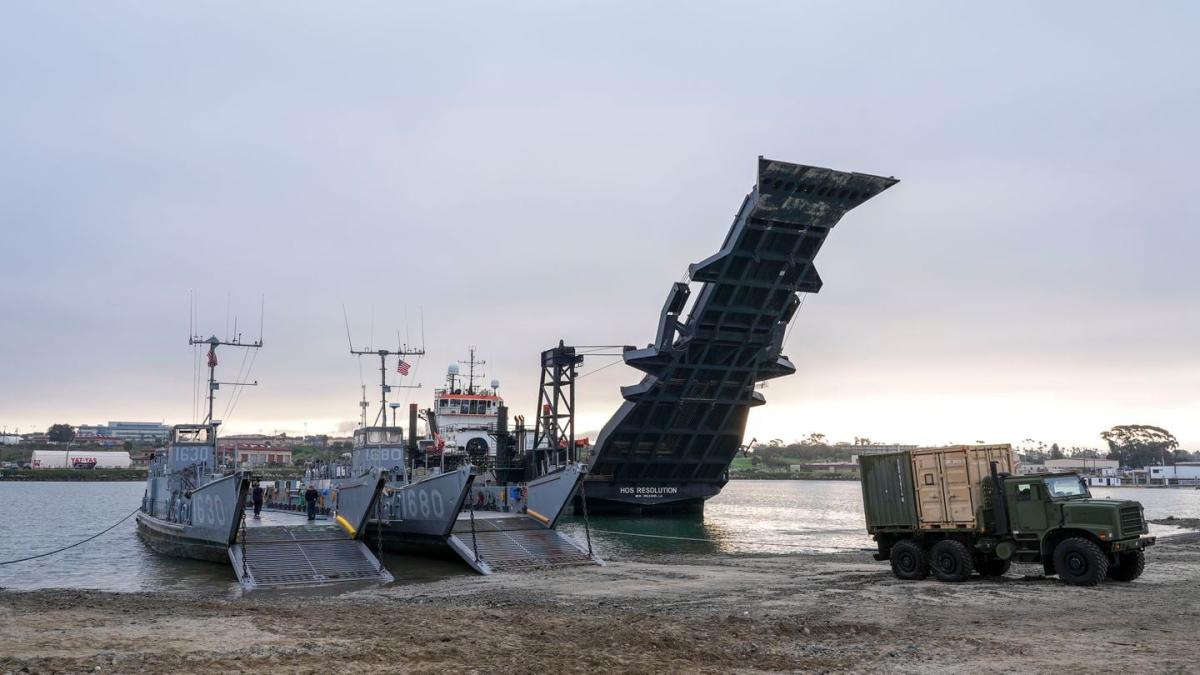A key ship the Marines need for a possible island shootout with China is two years behind schedule, could cost nearly triple the original estimate, and the short-term fix isn’t cheap.
The Navy’s medium landing ship program expects to award the design and construction contract in fiscal year 2025, two years later than originally planned, according to the Government Accountability Office’s Annual Weapons Systems Assessment, released Monday.
The concept, previously called the light amphibious warship, was launched in 2020 to acquire 35 such stern landing ships.
The ship would align closely with commercial designs to lower its signature and provide recently formed Marine coastal regiments with capabilities to maneuver in areas close to shore and within island chains, especially in the Pacific Ocean.
Marines expect a ‘big year’ for drone, ship and logistics tests
The current vessel used for testing is the Stern Landing Vessel, a modified commercial vessel that allows users to load and unload directly from the beach.
“It’s a shore-to-shore logistics connection to get heavy things that we can’t put on planes or don’t want a big ship to transport from point A to point B to move; maneuver it from point B to a more favorable position at point C; and then maintain that position,” Assistant Commandant General Christopher Mahoney said in March.
Original design features for the landing ship medium concept include:
-
A length of 200 to 400 feet.
-
A draft, or depth of the vessel below the waterline, of 12 feet.
-
A crew of about 70 sailors.
-
The capacity to carry 50 Marines and 648 short tons of equipment.
-
8,000 square meters of cargo space on deck
-
Transit speed of 14 knots and a sailing range of 3,500 nautical miles.
-
Roll-on/roll-off beach option for beaches with a slope of 1:40.
-
A landing site for a helicopter.
-
Two 30 mm guns and six .50 caliber guns for self-defense.
-
A lifespan of 20 years.
Source: Congressional Research Services
The first of the three planned regiments became operational in 2023. The Navy is developing a bridging strategy, according to the report. Marine Corps Times has reported on ongoing experiments with commercial ships modified over the past two years to meet the service’s landing needs.
But these solutions require “significant modifications,” costing more than $115 million per modified ship, according to the report.
A 2020 report from Congressional Research Services, which was updated in April, noted that Congress could consider adapting the Army’s existing fleet of logistics support ships to meet at least some of the Marines’ needs.
According to that report, the military has more than 100 such ships in its fleet. Dozens of these ships have similar capabilities to the landing ships the Corps is looking for.
At the time, the Army had been trying to divest part of its watercraft fleet. But the service has since shifted its logistics needs to the Pacific and is now looking to expand the fleet, Defense News reported.
Under the current timeline, the Navy expects to award the construction contract for the ships in March 2025 and deliver the first ship in January 2029. Under that schedule, the Navy expects to complete operational testing in July 2030 and reach initial capability in December 2034. This is evident from the report from the Government Accountability Office.
Another report released in April shows the total cost for the program is much higher than officials originally planned.
The Congressional Budget Office estimated that the initial 18-ship program could cost between $6.2 billion and $7.8 billion in inflation-adjusted dollars by 2024, Defense News, the Marine Corps Times’ sister publication, reported in April .
That translates to $340 million to $430 million per hull.
That’s three times more than the original $2.6 billion estimate for the program – or $150 million per ship.
If the Navy gets the green light to buy the entire fleet of 35 landing ships, as the Marine Corps has requested, the program will cost between $11.9 billion and $15 billion, according to the Congressional Budget Office report.
